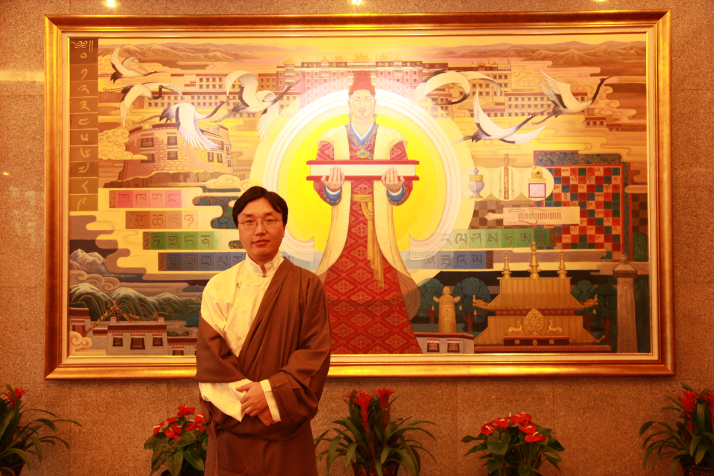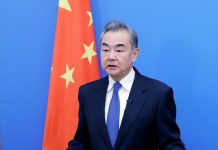
Counting nearly 9 million words, The General History of Xizang was meticulously compiled and written over more than 10 years by a team of over 100 researchers and authors, culminating in its publication roughly a decade ago.
This monumental literary work, spanning multiple volumes, is considered the first complete, comprehensive and systematic exploration of the general history of Xizang in southwest China, both domestically and internationally.
The books cover various historical events, cultural developments, political shifts and societal changes that have influenced Xizang’s trajectory through the ages. Delving into its vibrant history, traditions, customs, religious practices and geopolitical intricacies, each volume offers readers a profound insight into the region’s past and its significance within the broader context of Chinese history and culture.
Yan Yongshan, Deputy Director of the Institute of History Studies at the China Tibetology Research Center (CTRC), described the work as “epoch-making.”
He told Beijing Review about his most striking observation: Though the books were first released in 2015, they managed to document Xizang’s history up to 2014.
Launched by CTRC in 2002, this ambitious undertaking was completed through the combined efforts of Tibetologists and experts from different disciplines. This accomplishment both underlines the progress in China’s Tibetology research and has substantial academic and social significance.
Traditional Tibetan studies have a history of thousands of years in China, and the modern discipline of Tibetology is generally believed to have taken shape in the 1830s, according to Yan. Tibetology is the study and research of Xizang, covering its culture, history, language, religion and society.
Yan joined the project shortly after obtaining his Ph.D. in Tibetology from Minzu University of China and joining CTRC in 2008. As an editor, he maintained communication with leading Tibetologists across China, tracked the project’s progress, coordinated peer reviews and implemented necessary modifications.
“This big project helped transform a fledgling academic into a qualified historical researcher through practical experience,” the Tibetan scholar added.
A solid starting point
Yan credits the advancement of China’s Tibetology research to the overall development of the country, strong governmental support in terms of funding and policies, and especially, the impact of Xizang’s democratic reform.
This year marks the 65th anniversary of the democratic reform in the region, a historical event that remains vivid in memory. When the People’s Republic of China was founded in 1949, Xizang was still entrenched in centuries-old feudal serfdom. Some 95 percent of the population in the region were serfs, and any form of democratic governance was notably absent.
In 1951, the Central Government and the Xizang local government signed the historic Agreement on Measures for the Peaceful Liberation of Xizang (17-Article Agreement). The agreement stipulates: “The people of Xizang shall unite and drive out aggressive imperialist forces; they will return to the family of the People’s Republic of China,” “The Tibetan people shall have the right of regional ethnic autonomy under the unified leadership of the Central People’s Government” and “The religious beliefs and customs of the Tibetan people shall be respected.”
The signing of the 17-Article Agreement symbolized the final liberation of all the Chinese mainland, embodied the full sovereignty of the People’s Republic in Xizang, united all forces to safeguard overall social stability, ensured the enforcement of the Communist Party of China’s ethnic, religious, economic and cultural policies, and laid a solid political foundation for social development and reform in Xizang, according to Tibet Since 1951: Liberation, Development and Prosperity, a white paper released by the State Council Information Office in May 2021. The State Council is China’s highest state administrative organ.
In response to local conditions in Xizang, the Central Government in 1956 decided that no reform would be implemented there for the next six years. However, members of the ruling class, determined to maintain serfdom, staged an armed rebellion in March 1959. After suppressing the rebellion, the Central Government initiated democratic reform to abolish feudal serfdom, dismantling the old system and paving the way for the establishment of Xizang Autonomous Region.
The reform emancipated more than 1 million serfs, giving the previously exploited, underprivileged people the right to vote to elect their local political representatives and stand for election for the first time. The First Session of the First People’s Congress of Xizang Autonomous Region, the regional legislature comprising elected deputies, convened in September 1965, officially declaring the formation of the autonomous region.
“The democratic reform broke the three chains that bound the serfs,” Yan said. The first chain was the political one: They were emancipated and became masters of their own destiny and region. The second chain was the restriction on their way of life: they gained the freedom to pursue financial independence and live autonomously. The third chain related to spiritual shackles: they began to break free from the thought control of religion under theocracy, a development that became a crucial element in the advancement of Tibetology research over the decades that followed. Additionally, the democratic reform gave the general public the right to education, expanding the potential talent pool for Tibetology research.
This transformation had profound effects on the region’s social and economic landscape.
According to a white paper released by the State Council Information Office in November 2023, Xizang has experienced impressive economic growth in recent years. In 2022, the region’s GDP, which serves as an indicator of an economy’s size and health within a given time period, reached 213.26 billion yuan ($29.62 billion), a substantial surge from 2012 and representing an average annual growth rate of 8.6 percent.
Additionally, the region’s per-capita disposable income had risen substantially to 26,675 yuan ($3,705) in 2022 from 8,568 yuan ($1,190) in 2012, representing the country’s highest growth rate for eight consecutive years since 2015.
Expanding on these economic advancements, the white paper further highlighted that the region had 3,409 schools, offering diverse academic programs to over 944,000 students as of late 2022.
Moreover, the gross enrollment rate for preschool education had reached 89.52 percent, while that for senior high schools surged to 91.07 percent. The completion rate for compulsory education (spanning 15 years, compared to nine years in most parts of China) had reached 97.73 percent at the end of the same year.

An academic assortment
“Tibetology covers many subjects,” Yan explained. It includes topics related to Xizang, as well as all disciplines within philosophy and the social sciences, such as history, political system, economy, religion, culture, folk customs, literature, and art. Additionally, it incorporates aspects of the natural sciences, such as mathematics, medicine, geography and astronomy.
Lumucao, a researcher at CTRC, specializes in Sanskrit studies, with a particular focus on Sanskrit palm-leaf scriptures.
Considered one of the ancient languages of the world, Sanskrit is incredibly rich in content. Many Sanskrit Buddhist scriptures have been discovered in China, with the Sanskrit palm-leaf scriptures standing out as especially significant.
Most of these valuable ancient documents, written in Sanskrit on dried palm leaves, are preserved as treasures in monasteries and
museums in Xizang. The considerable number of Sanskrit manuscripts found in Xizang holds great historical and cultural value.
Lumucao began studying Sanskrit-related work in 2010 after joining the center. “After having worked at the center for several years, I decided to pursue my Ph.D., selecting the ancient language as my research focus,” the scholar told Beijing Review.
It is a challenging subject that requires persistence; typically, it takes 10 to 20 years of training before one can call themselves a qualified Sanskrit expert—a much longer duration compared to other ancient languages.
The Chinese Government has emphasized the preservation of Sanskrit literature in Xizang. Special personnel have been assigned to collect Tibetan Sanskrit scriptures, and multiple measures have been adopted to protect the Sanskrit palm-leaf scriptures in the Potala Palace and Norbu Lingka garden, both located in Lhasa, the regional capital. The government also invests in cultivating Sanskrit researchers, according to Lumucao.
Suolangzhuoma, a young researcher at CTRC, has developed an interest in Tibetan Buddhism, especially in the dakini, a term derived from Sanskrit that translates to “sky dweller” or “sky dancer.” Dakinis are female embodiments of enlightened energy, representing the feminine principle in Tibetan Buddhism.
Suolangzhuoma began studying Tibetology during her master’s degree program. Growing up with a Tibetan-standard Chinese bilingual education from a young age equipped her with the necessary language skills to quickly adapt to this new academic field.
“People might think Tibetan Buddhism is mysterious and I think this stereotype stems from a sense of unfamiliarity, which in turn feeds the perception,” Suolangzhuoma expressed her ongoing fascination with the religion, while emphasizing that there are still many aspects waiting for her to explore further.
“Being a Tibetan, having grown up in a modern environment, studying Tibetology and finally joining the top Tibetology research center in China, my passion thrives,” Yan said, expressing his gratitude for the opportunities he has had and his desire to contribute to the development of Tibetology.
Yan emphasized the significance of China in the field of Tibetology, saying, “The roots of Tibetology lie within China, where the most related historical documents are housed.”
Highlighting the progress in Tibetology research within China, Yan noted, “China has established a comprehensive research team and system wholly dedicated to Tibetology, underscoring the country’s commitment to advancing scholarly pursuits in this field.”

An international eye
CTRC has partnered up with different overseas universities and institutions, including the Austrian Academy of Sciences in Austria, the University of Hamburg in Germany, the University of Naples in Italy and Ryukoku University in Japan.
“Some international Tibetologists have been engaged in Tibetology research longer than we have, in certain areas, and can offer insights and experiences,” Lumucao said. She also expressed her intention to collaborate with a German professor to study a Sanskrit document, which is the sole surviving copy without any translations in other languages.
“They can also provide us with different perspectives,” Suolangzhuoma added. Throughout her process of studying the dakini, she has read different interpretations by overseas experts, prompting her to challenge her own perspectives.
Yan noted that there are challenges in accurately portraying the reality of Xizang, largely due to limited knowledge about the region among overseas researchers.
“Xizang is like coffee. You have to sieve and brew it yourself and then you have to try it,” Suolangzhuoma told the audience at an event titled Human Rights and Chinese Modernization in Geneva, Switzerland, on January 24. The video of her speech later went viral on Chinese social media platforms.
During that event, she also underlined the combined impact of policy support, financial investments, educational programs, training initiatives and international exchanges, and the active engagement of local residents and related institutions, which have altogether propelled the preservation and development of Xizang’s cultural traditions.
The sentiment that “seeing is believing” was echoed by all three scholars. –The Daily Mail-Beijing Review news exchange item





